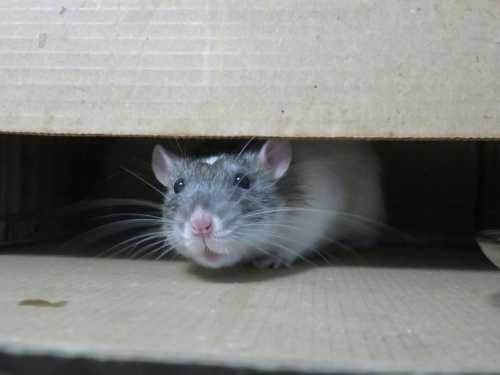
Rats are extremely adaptable, intelligent and hardy creatures, able to survive in almost any, even the most extreme conditions. Their population is especially large in cities, where proximity to humans provides constant access to food and warmth, which is a significant advantage compared to the harsh conditions of the wild. Unfortunately, wild rats can carry various diseases, which is often the reason for the negative attitude towards them by humans.
Extreme sociality
Rats are very social creatures and always live in packs. For them, communication is vital: it is strictly not recommended to keep ornamental rats alone, as without interaction with their own kind they can suffer from stress, depression and even illness. Social isolation negatively affects their psychological and physical health, leading to apathy and a reduced quality of life.
High intelligence and trainability
Rats exhibit outstanding cognitive abilities and are easily trainable. They are actively used in scientific research to study memory, learning, and behavior, as they are able to master complex tasks, solve puzzles, and even complete miniature missions, demonstrating their impressive mental flexibility.
Invaluable role in scientific research
In addition to studying memory and behavior, rats are key models in a wide range of biomedical research. Due to their genetic proximity to humans (albeit distant), similar physiology of many organs and systems, short life span, and relatively easy handling, they are used to study cancer, diabetes, cardiovascular disease, neurological disorders (e.g., Parkinson's and Alzheimer's), and to test new drugs and therapies. Their predictable behavior and ability to learn make them ideal for modeling human diseases and responses.
Life
In captivity, rats live an average of two to three years. In the wild, their lifespan is much shorter—about half that. This is due to the many threats in the wild: predators, limited access to food and water, harsh weather conditions, and a high risk of disease, which significantly shorten their lifespan.
Sensitivity to changes in the environment
Rats do not “predict the future” in the mystical sense, but they are extremely sensitive to the slightest changes in their environment. Their acute senses – exceptional hearing, smell, vibrissae (whiskers) that respond to touch and vibration, and the ability to sense changes in atmospheric pressure – allow them to react to danger in advance, for example, leaving buildings before earthquakes or military training grounds before weapons tests. This is a manifestation of their developed instincts, not paranormal abilities.
Altruism and caring for relatives
Rats show social concern for their weakened or sick relatives. They may share food with them and provide warmth with their bodies. Studies have shown that rats are willing to overcome obstacles to help a relative in distress, which is a striking example of empathy and altruistic behavior in the animal kingdom.
Evolutionary history
The ancestors of the rodent family, to which rats belong, appeared on Earth about 60 million years ago. The genus Rattus (true rats) itself arose much later, about 2-5 million years ago. This is long before the appearance of modern humans (Homo sapiens), who evolved about 300,000 years ago.
The population myth
The claim that there are twice as many rats as people in the world is a common myth. In fact, it is impossible to accurately estimate the global rat population. Most estimates indicate that their numbers are significantly smaller than the human population, although in certain urban settings where resources are abundant, the ratio can approach 1:1. This is a local phenomenon, not a global figure.
Dominant species
When people talk about urban rats, they most often mean the gray rat (Rattus norvegicus), or Norway rat (Rattus norvegicus). This species originates from Central Asia, but thanks to its incredible adaptability and ability to reproduce rapidly, it has spread throughout the world, becoming one of the most successful invasive species. It is the gray rat that is the main object of scientific research and the species that most often comes into conflict with humans, inhabiting sewage systems, basements and landfills.
Rats as food
In some countries, including Vietnam, rats are eaten. They are usually field rats that live away from urban waste, and they are a source of protein and part of the traditional cuisine in some regions.
High jumps
A rat can jump vertically to a height of about 70-80 centimeters, and horizontally up to 1.2 meters. These are very impressive figures for an animal of this size. This ability helps them overcome obstacles and avoid danger.
Self-preservation instinct and height
Rats do not suffer from “lack of fear of heights.” On the contrary, they have an excellent sense of balance and spatial orientation. They are careful and skilled climbers who carefully assess the risks before moving on high surfaces. Falls, if they occur, are usually caused by an accidental loss of balance.
Rapid heartbeat
A rat's heart beats up to 500 times per minute. This is due to their high metabolism and small body size. Small mammals tend to have faster heart rates because they need to maintain a high body temperature and high metabolism to survive.
Temperature adaptation and control
Rats have a relatively high core body temperature (about 37.7 °C) and, unlike many other mammals, lack sweat glands, except in their paws. They use their long, scaly tail to regulate their temperature, which acts as a radiator, dilating or constricting blood vessels to cool or conserve heat. This feature, along with their ability to seek shelter in burrows and near heat sources, allows them to survive in a wide range of temperatures, from hot to freezing conditions.
Endurance swimmers
Rats are excellent swimmers and can hold their breath underwater for several minutes. They are able to cover considerable distances in water, which allows them to navigate through sewer systems, rivers and flooded areas. They can stay afloat for several hours.
Exceptional cleanliness
Contrary to popular belief, rats are very clean animals. They spend a significant amount of their time grooming themselves, constantly licking their fur and using their paws to clean their faces. This not only maintains hygiene, but also serves as an important social ritual within the pack. The only part of their body that they clean less often on their own is their scaly tail, which is less accessible for self-grooming.
Direct vectors of diseases
Rats themselves are direct carriers of many dangerous diseases. They can spread diseases such as leptospirosis, salmonellosis, hantavirus, rat fever, and others through their excrement (urine, feces), saliva, and bites.
“Laughter” in rats
Rats, like humans, can “laugh,” albeit in their own way. In response to pleasurable stimuli, such as play or tickling, they emit ultrasonic “chirps” (50-kHz vocalizations) that the human ear cannot hear. Scientists interpret these sounds as an indicator of a positive emotional state, analogous to laughter in humans.
Daily distance
Typically, their daily foraging and patrolling radius ranges from a few hundred meters to several kilometers, depending on resource availability. Longer distances are the exception rather than the rule.
Continuous tooth growth
Like other rodents, rats' incisors grow throughout their lives. Therefore, rats need to constantly gnaw on hard objects to keep them sharp. If this does not happen, their teeth can grow back, causing serious health problems that prevent them from eating.
Difficult communication
Rats communicate by squeaking, but more commonly use an ultrasonic “throat whistle,” inaudible to the human ear. These ultrasonic vocalizations are highly complex and play a key role in their social interactions, conveying information about danger, food location, social status, and emotional state. Different types of calls are used in different contexts, from distress signals to mating calls.
Fantastic sense of smell
It takes a rat only a fraction of a second to determine the direction to the source of a detected odor. Their sense of smell is extremely developed and is one of the most acute among mammals. They use it to find food, detect predators, navigate, and recognize other rats. Thanks to their movable nostrils, rats are capable of “stereo-smell,” accurately locating the source of an odor in space.
Vision and night adaptation
Rats have relatively poor eyesight, especially in terms of detail and color. Their field of vision is wide, but they are farsighted and see the world in blurry gray-green tones. However, their eyes are well-adapted to low light conditions, allowing them to navigate effectively in twilight and darkness. This is why rats are mostly nocturnal, relying on their highly developed sense of smell, hearing, and whiskers to navigate and find food.
Food consumption
A single rat consumes approximately 10-12 kilograms of food per year. On average, this amounts to about 15-30 grams per day. Their voraciousness and omnivorous nature make them significant pests for agriculture and food supplies.
Rats dream.
Like most mammals, rats dream. Studies of their brain waves during rapid eye movement (REM) sleep show activity similar to that seen in humans. It is believed that dreaming helps them consolidate memories and process experiences from the day.
Medieval exorcism
There were notable instances in the Middle Ages when European bishops ordered rats to be excommunicated. This was an absurd but formal act that reflected the people's despair over the spread of plague and crop destruction attributed to rats. Such “sentences” were often issued to a specific rat population in a particular region, rather than to the entire genus.
Skeleton structure
The number of bones in the rat skeleton (about 225-230) only partially coincides with the number of bones in the human skeleton (about 206). Although these numbers are not identical, they are quite close and emphasize the general plan of the mammalian skeleton, despite significant differences in size and shape.
High reproductive rate
A female rat can give birth to up to a hundred young rats per year. This is due to the short gestation period (about 21 days), the large number of rats in the litter (up to 12 or more), and the rapid sexual maturation of the young, which allows them to have up to 5-10 litters per year. This high reproductive capacity is the key to their survival and spread.
Food regulation and supplies
In the wild, they are good at regulating their intake due to resource constraints. However, in laboratory conditions, with unlimited access to high-calorie food, rats can gain excess weight. However, they tend to store food, similar to hamsters, which is an important survival strategy to ensure food security during times of scarcity.
Omnivorous predators
In nature, rats are omnivorous and actively hunt a variety of small animals, including mice, lizards, chicks, insects, and eggs. Their diet is extremely varied and can include grains, fruits, vegetables, and carrion, demonstrating their extraordinary adaptability in finding food sources.
Phenomenal memory
Rats have an impressive spatial memory. Once they have followed a route or found a food source, a rat will remember it for the rest of their lives. This ability is essential for their survival, allowing them to navigate their environment effectively, find shelter, and avoid dangerous places.
Colony size
A single large rat colony can contain up to 2,000 individuals under favorable conditions. Such huge groups are formed when there is sufficient food and shelter, as well as an absence of natural enemies. Within such colonies, there are complex social hierarchies and interactions.
The destructive power of teeth
Rats can gnaw through many hard materials, such as wood, plastic, lead, aluminum, and soft concrete and cement. However, they cannot gnaw through pure iron because their teeth and jaws are not strong enough to do so. This ability allows them to create tunnels and access food caches.
Group hunting
A pack may attack prey larger than themselves, but this is usually on weakened, sick or young animals. Their coordinated attack and sheer numbers allow them to overcome resistance from their prey that a single rat would not be able to overcome.
Sacred rats of Karni Mata temple
The Indian temple of Karni Mata in Deshnok is home to over 20,000 rats. These rats, called “kabas,” are considered sacred, and their presence in the temple is associated with the legend of the goddess Karni Mata and her family. Devotees come from all over to worship these animals, feed them, and receive their blessings.





